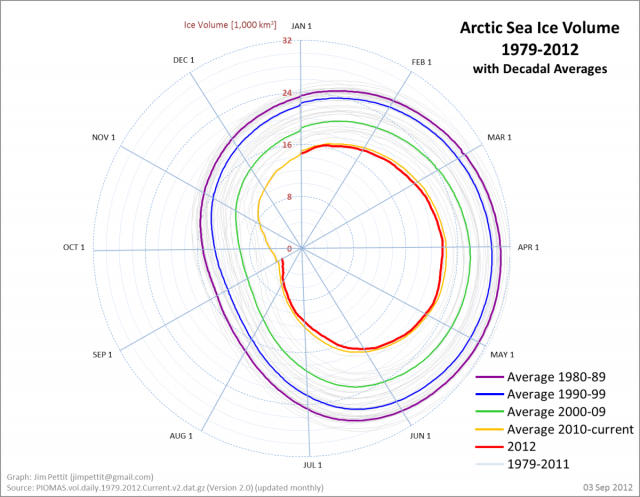12 September 2012
The catastrophic loss of Arctic Sea Ice and its implications for landslides
Posted by Dave Petley
This summer has seen an extraordinary melt season in the Arctic, which has led to a catastrophic and unprecedented loss of sea ice. The rate at which the Arctic Ocean has lost ice volume is illustrated brilliantly by a series of graphs on Jim Pettit’s website. These graphs make depressing viewing – there can be no clearer illustration of the environmental impacts that our reckless global-scale atmospheric chemistry experiment is having. To me perhaps the most dramatic is this graph of the PIOMAS data on Arctic Sea Ice Volume:
 This is the graph that some are terming the “Death Spiral”, although I think that such superlatives can be a little unhelpful. It is not hard to see the way in which the loss of ice volume has accelerated in recent years, or just how little there is left at the end of the summer melt season this year. A summer with an ice-free Arctic Ocean is quite within the bounds of possibility within a decade.
This is the graph that some are terming the “Death Spiral”, although I think that such superlatives can be a little unhelpful. It is not hard to see the way in which the loss of ice volume has accelerated in recent years, or just how little there is left at the end of the summer melt season this year. A summer with an ice-free Arctic Ocean is quite within the bounds of possibility within a decade.
You may well be wondering what this has to do with landslides. Of course in the high latitudes, and at high elevations, there is a direct effect as melting permfrost is increasing the likelihood of landslides and rockfalls. However, there may well be a more subtle but significant effect. In a paper published this year, Francis and Vavrus (2012) suggested that there are some interesting effects of the changing temperature balance between the high latitudes and the mid latitudes in the Northern Hemisphere. Essentially this is the effect known as arctic amplification (AA), in which the high latitudes are warming more rapidly than areas further to the south. This in turn is changing the characteristics of the jet stream, which is a key factor in determining the weather conditions in the mid-latitudes of the Northern Hemisphere. The analysis suggested that as a result of AA, the jet stream is developing a structure that is more wavy, and this in turn is causing weather systems in the mid-latitudes to change more slowly. Thus, droughts, extreme rainfall events and even cold weather spells are likely to become more frequent and longer lasting.
This summer has of course seen a dramatic illustration of this, with extreme drought conditions across a large swathe of North America. In the UK we had a prolonged spell of wet weather in the first half of the summer – it ended just in time for the Olympics – which has meant that 2012 is the wettest summer in a century. The upshot has been landslides affecting the rail network, coastal cliffs and inland areas. Three people were killed by these landslides. It seems likely that such events will become more common across the mid-latitudes, interspersed with at least some rather intense cold weather spells and summer droughts.
Which of course brings us back to the Arctic sea ice. This exceptional melt season will further enhance AA, and there is a strong feedback mechanism operating in this area. Unfortunately, the loss of the ice causes a reduction in albedo (reflectivity), meaning that more heat is trapped in the ocean. The net effect is an acceleration of the warming trend in the high latitudes.
So, unfortunately, the loss of Arctic Sea Ice is likely to have an impact on landslides in the mid-latitudes. Just how intense this effect will be is unclear. We still have a great deal to learn about the ways that the different components of the climate system interact.
Reference
Francis, J. A. and S. J. Vavrus (2012), Evidence linking Arctic amplification to extreme weather in mid-latitudes, Geophys. Res. Lett., 39, L06801, doi:10.1029/2012GL051000.


 Dave Petley is the Vice-Chancellor of the University of Hull in the United Kingdom. His blog provides commentary and analysis of landslide events occurring worldwide, including the landslides themselves, latest research, and conferences and meetings.
Dave Petley is the Vice-Chancellor of the University of Hull in the United Kingdom. His blog provides commentary and analysis of landslide events occurring worldwide, including the landslides themselves, latest research, and conferences and meetings.